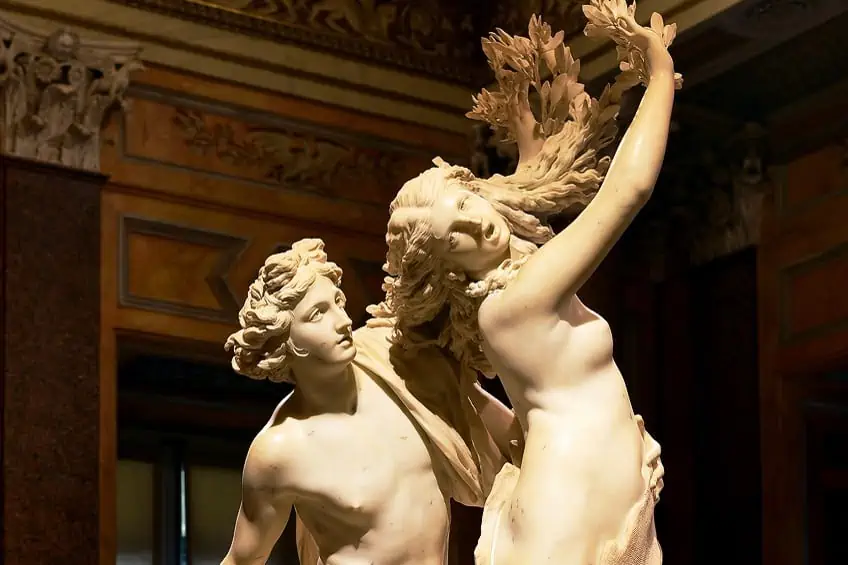Famous Renaissance Sculptures – The Top Renaissance Art
The Renaissance gave rise to many great masters in art history and was an incredible time of development in sculpture, especially during the Italian Renaissance. The artistic development during this time is particularly significant because it marked the period in European history that witnessed the transition from the Middle Ages into modernity and along with this came development in thinking around how art is portrayed in sculpture. This article will explore the most famous sculptures of the Renaissance while unpacking the significance of art from this period.
Contents
- 1 Renaissance Art
- 2 Top 10 Famous Renaissance Sculptures
- 2.1 Porta del Paradiso (1425 – 1452) by Lorenzo Ghiberti
- 2.2 David (1430 – 1440) by Donatello
- 2.3 Judith and Holofernes (1457 – 1464) by Donatello
- 2.4 Pietà (1498 – 1499) by Michelangelo
- 2.5 Madonna of Bruges (1501 – 1504) by Michelangelo
- 2.6 Cristo della Minerva (1514 – 1521) By Michelangelo
- 2.7 Abraham and Isaac (1526 – 1532) by Alonso Berruguete
- 2.8 Perseus with the Head of Medusa (1545) by Benvenuto Cellini
- 2.9 Abduction of a Sabine Woman (1579 – 1583) by Giovanni da Bologna
- 2.10 Apollo and Daphne (1622 – 1625) by Gian Lorenzo Bernini
- 3 Frequently Asked Questions
Renaissance Art
The Renaissance is defined as a European period in history, between the 14th and 16th centuries. The Renaissance is acknowledged as a significant period that saw the rebirth of ideas around philosophy, science, politics, culture, and art, and is thus a great source of study for many.
This period also included the rediscovery of classical subjects and literature that influenced the subject matter of many Renaissance artists.

Some of the most notable influencers of art history operated during the Renaissance and include the Mona Lisa (1503) by Leonardo da Vinci, The Divine Comedy (1308 – 1320) by Dante Alighieri, Venus and Adonis (c. 1540 – 1565) by Titian, and many more brilliant artworks and sources of inspiration.
Renaissance Sculpture
Sculptures of the Italian Renaissance emerged in Florence during the 15th century and are said to be heavily influenced by classical sculpture. It is important to note that Florence was also dubbed the cradle of the Renaissance due to its status and affiliation with being the home of the wealthiest patrons in Europe and the largest city.
Italian Renaissance sculpture drew inspiration from earlier classical antiquity styles.
It is believed that the art of sculpture originated from a competition held in 1403 for the design of the Florence baptistery, which saw many submissions. The winner of the competition was Lorenzo Ghiberti, one of the first Renaissance sculptors, followed by Fillipo Brunelleschi.
Top 10 Famous Renaissance Sculptures
Many famous Renaissance sculptures borrow from classical antiquity and include subjects related to mythological figures from Graeco-Roman cultures as well as biblical narratives reimagined through the lens of the artist. Below, we will examine the top 10 most famous sculptures from the Renaissance period.
Porta del Paradiso (1425 – 1452) by Lorenzo Ghiberti
| Artist | Lorenzo Ghiberti (Lorenzo di Bartolo) (1378 – 1455) |
| Date | c. 1425 – 1452 |
| Medium | Bronze |
| Dimensions (m) | 2.1 |
| Where It Is Housed | Baptistery of the Duomo, Florence, Italy |
Ghiberti’s winning submission for the sculpture competition was a pair of bronze doors decorated with 28 panels showcasing religious scenery of the life of Jesus Christ as well as the four Evangelists and various Saints. The project was completed after 21 years and remains at the entrance of the baptistery.
The second set of doors, as seen above, called The Gates of Paradise, were commissioned around 1425 and executed over a 27-year period.
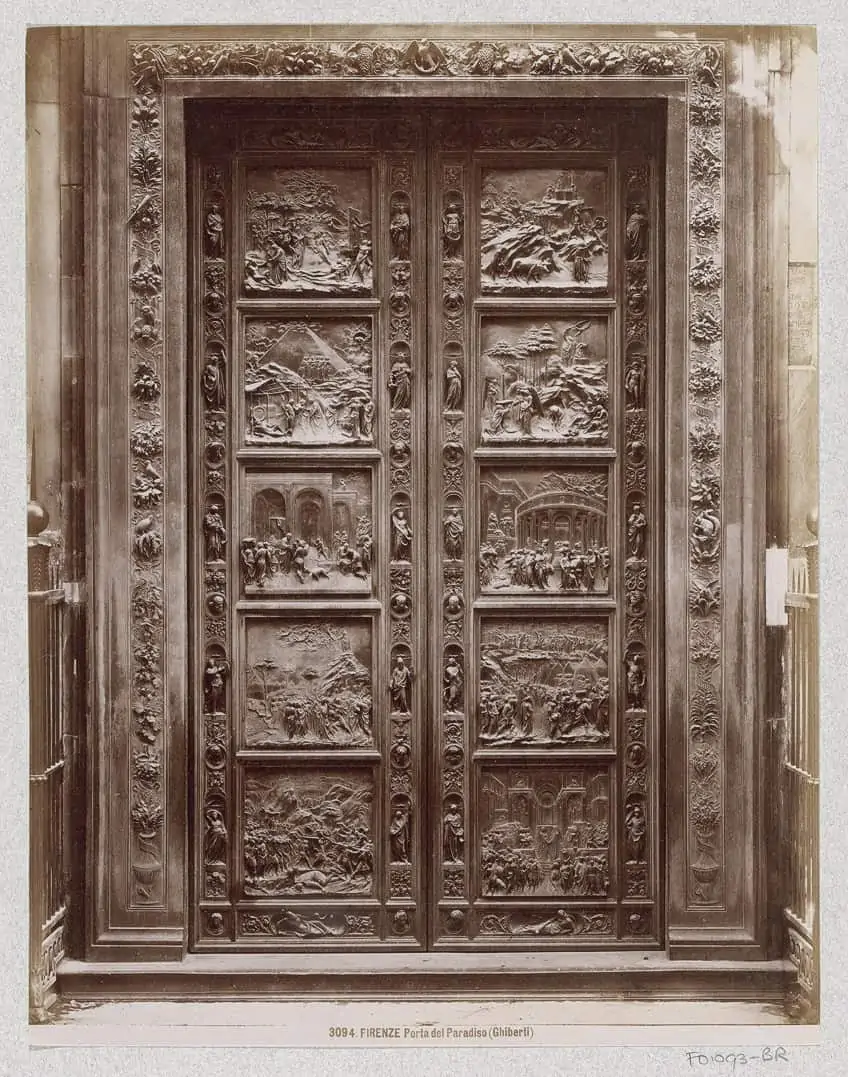
The Gates of Paradise represented biblical scenes from the Old Testament and contained elements of depth and perspective among the 10 panels. These doors were heavily decorated and encapsulated by a framework containing busts of the sculptor, fruit, foliage, and small statues of the prophets. The panels on The Gates of Paradise include the following narratives from the bible.
Adam and Eve
This panel showcases the story of Adam and Eve from the first chapter of the bible, Genesis, which describes the creation of the Universe, the Garden of Eden, and the first humans, Adam and Eve. The scene portrays Eve who was tricked by one of God’s fallen angels, Satan (Lucifer).
Satan poses as a serpent on the bottom left of the scene.
Cain and Abel
The story of Cain and Abel follows the first major narrative of creation and disobedience into the sons of Adam and Eve, Cain and Abel. According to the narrative, Cain became jealous of his younger brother Abel, who was shown favor by God for his offering. The panel shows Abel seated peacefully with his herd and at the bottom, illustrates Cain tricking Abel and murdering him.
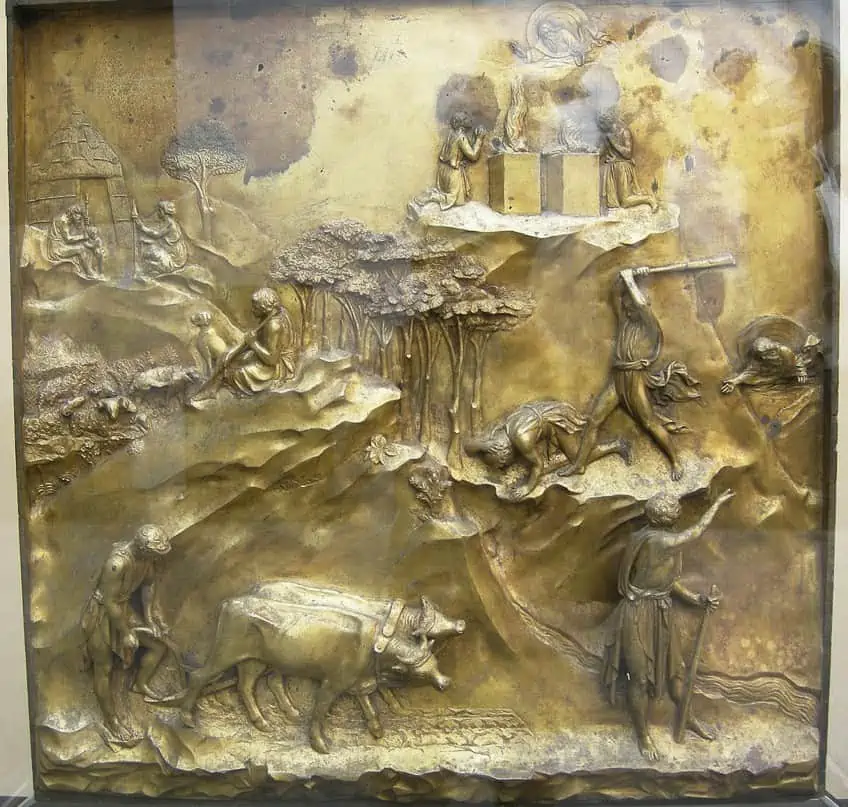
Noah’s Ark
This panel was inspired by the tale of God declaring that he was about to destroy the Earth because of the apparent violence that ensued. He commanded Noah to build an Ark and save only two of each kind of animal as seen in the imagery on the panel.
Ghiberti also sculpted Moses lying next to a barrel to signify the character of the disobedient people and on the bottom right, he shows Moses offering up a sacrifice.
Abraham
This panel illustrates the three angels who approached Abraham and prophesied that God willed them to bear a child even though they were well into their old age. However, once they had a child, whose name would be Isaac, they would have to sacrifice him to God.
Isaac
The test given to Abraham was to kill his own son but as seen in the panel by Ghiberti, an angel halted Abraham from following through with the act which led to Isaac being spared. Jacob is also seen on the right receiving blessings.
Rebecca is seen on the rooftop listening to a message from God.
Joseph
This panel illustrates the story of Joseph who was sold off as a slave by his jealous brothers to Egypt. Joseph eventually became a consultant for interpreting people’s dreams and was even requested by Pharaoh to explain a dream.
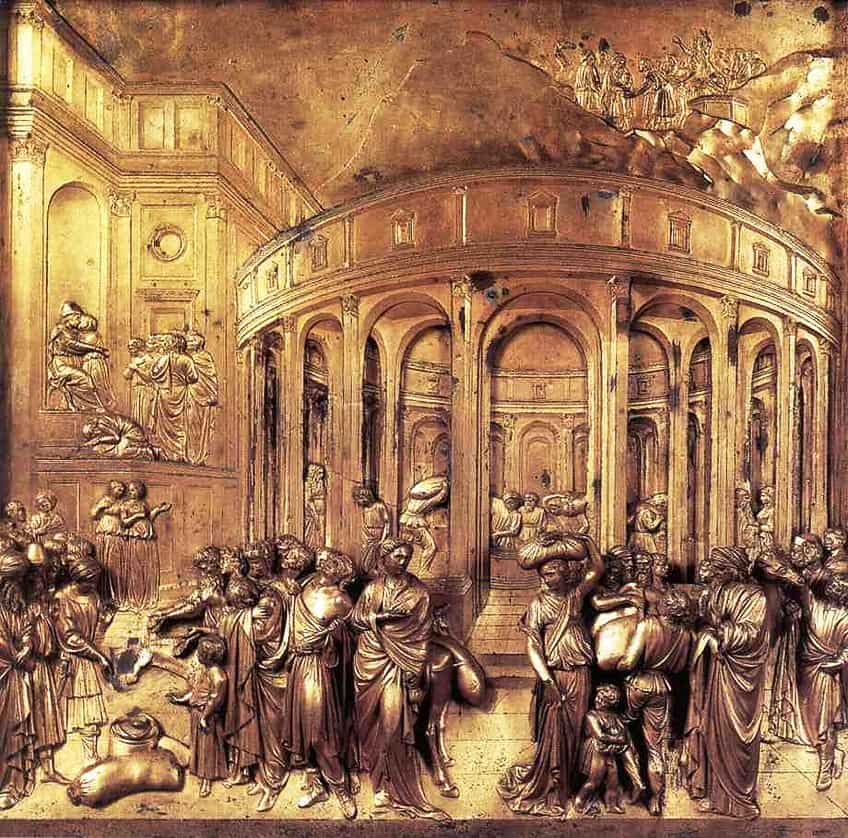
Moses and the Red Sea
The tale of Moses follows his abandonment at the Nile River in a basket and his subsequent adoption by the daughter of Pharaoh. Originally an Israelite, Moses became a man of Egypt with significant status, however, his people, the Israelites, were at the time enslaved to the Egyptians. Ghiberti shows us the 10 plagues that frightened the people of Egypt on the right side of the panel as well as Moses guiding the Israelites to the Red Sea while rejoicing at their long-awaited freedom.
At the top of the panel, we see Moses receiving the 10 commandments while standing on Mt. Sinai.
Joshua and the Promised Land
After Moses passed, Joshua assumed leadership over the Israelites and it was his duty to lead them into the “promised land” as depicted at the bottom of the panel. The panel also features a river stream representing the river Jordan, which the people were meant to cross. Joshua’s task was to travel around the city of Jericho several times with the 10 commandments, which resulted in the walls of the city collapsing. At the top of the panel, one can observe Joshua with his army, victoriously conquering the city.
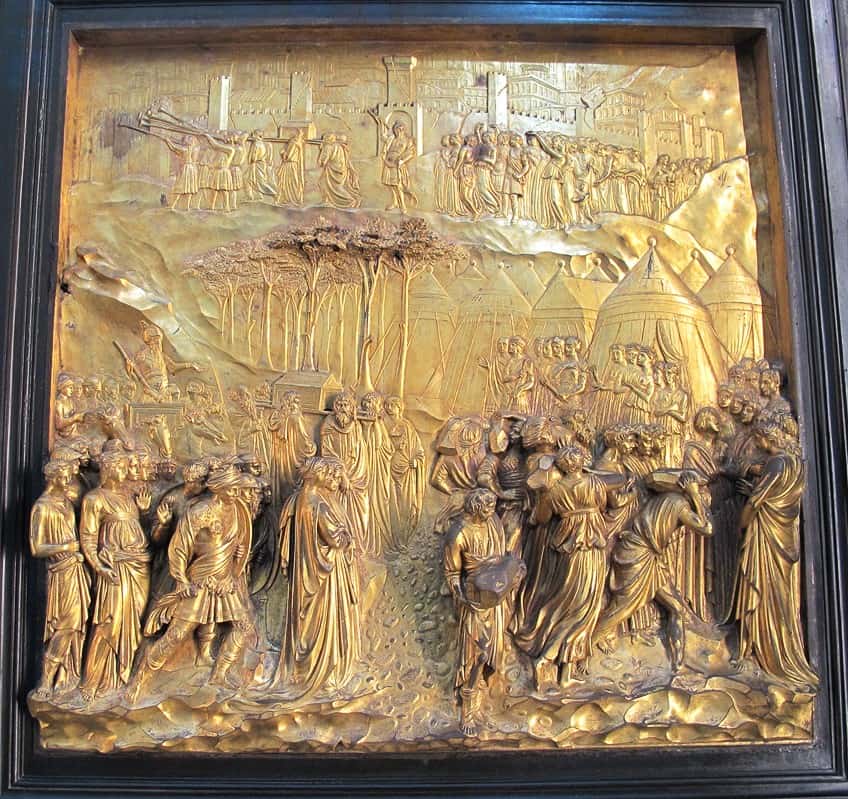
David and Goliath
This panel shows the war that ensued between Israel and Egypt. During this time, David was sought out by Samuel, who was a prophet, to find a new King for the Israelites. The panel illustrates David in the act of killing Goliath with a sword.
This was after he slung a rock at the giant.
King Solomon
This panel illustrates the alliance that King Solomon made with the Pharaoh involving the marriage of his daughter. Solomon was granted the gift of wisdom to better lead the people and the panel shows this by illustrating a celebratory crowd. The next part of the story involves two prostitutes who both fell pregnant by King Solomon but one baby died. Both women claimed that the baby was their own but upon Solomon’s command that the baby is cut in half so that they could share, the liar was exposed and the real mother of the child was rewarded.

David (1430 – 1440) by Donatello
| Artist Name | Donato di Niccolò di Betto Bardi (1386 – 1466) |
| Date | 1430 – 1440 |
| Medium | Bronze |
| Dimensions (cm) | 158 |
| Where It Is Housed | Palazzo del Bargello, Florence, Italy |
One of the most famous Renaissance sculptures in the world is David (1430-1440) by famous Florentine sculptor Donato di Niccolò di Betto Bardi, better known as Donatello. Although spending a lot of time in different cities, Donatello primarily drew his inspiration from his education in classical sculpture and later went on to produce this revolutionary statue of David, which was recognized as the first standing male nude statue since the era of antiquity.
Created out of bronze, this statue represents the biblical hero David, who was famous for his victory over slaying the giant Goliath.
What makes Donatello’s statue of David so unique and popular was that it must have been a spectacle at the time for its unapologetic display of a poised male nude, dressed only in his boots and armor. Art critics believe that Donatello was also pushing for a representation of the queer gaze and that David was a statue with “homoerotic qualities”, alluding to Donatello’s sexuality.
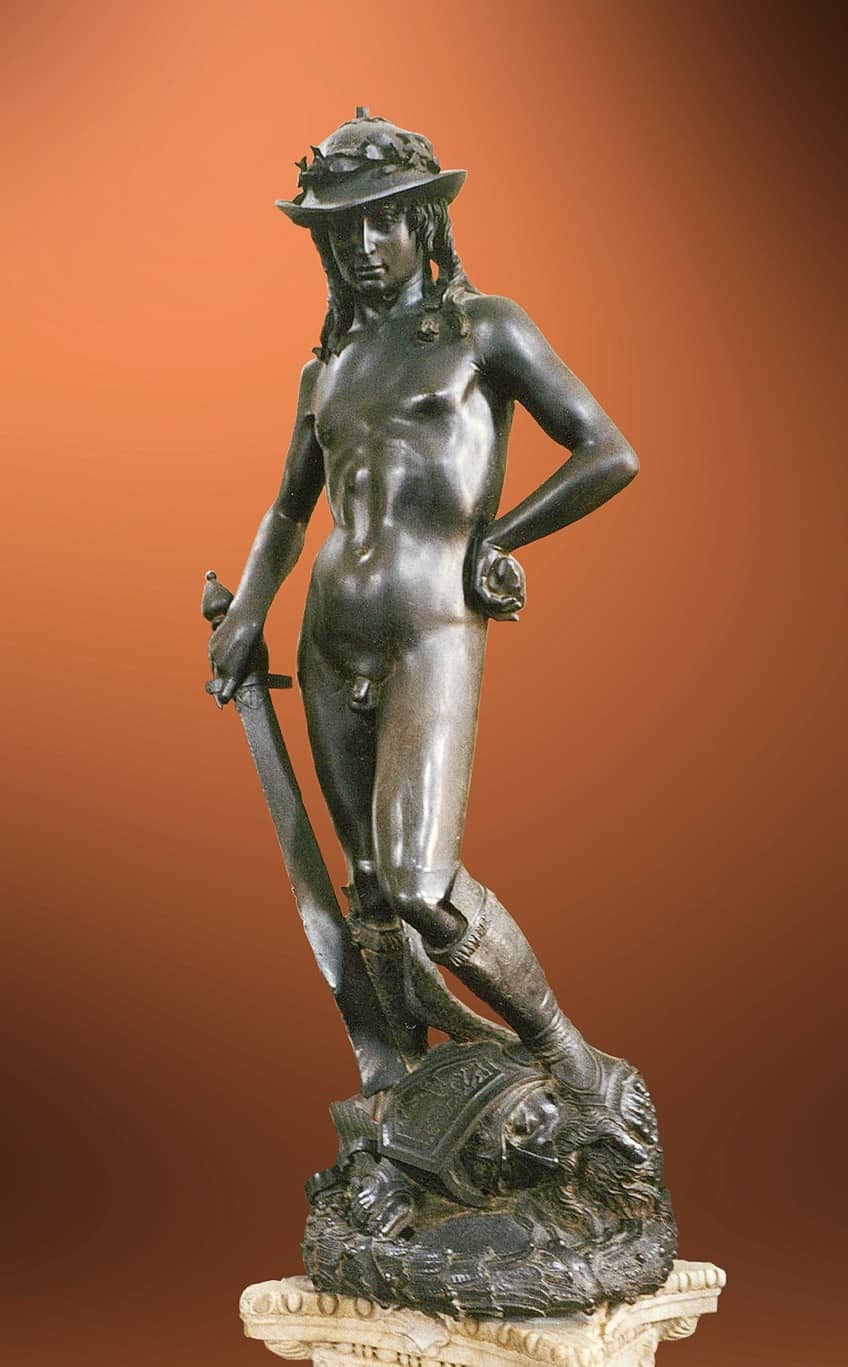
David by Donatello also stands out for its sculptural qualities in the representation of a hero who was often portrayed as muscular and heroic. Here, we see the character sculpted with smooth skin and his hand resting calmly on his hip as he plants his foot over the head of the Philistine conqueror.
The back of the statue also appears androgynous since one cannot determine the gender by viewing the statue from the back alone.
Donatello’s patron was no other than one of the wealthiest families in Italy, Cosimo de’Medici of the Medicis who commissioned the piece for the Palazzo Medici court. The statue is said to serve as an “allegory of civic virtues overcoming brutality and ignorance” and was a crucial turning point in the development of Renaissance sculpture as a whole. David had become one of the first sculptures that had been created independent of architecture.
Judith and Holofernes (1457 – 1464) by Donatello
| Artist Name | Donato di Niccolò di Betto Bardi (1386 – 1466) |
| Date | 1457 – 1464 |
| Medium | Bronze |
| Dimensions (cm) | 236 |
| Where It Is Housed | Palazzo Vecchio, Florence, Italy |
This famous Renaissance sculpture was created by Donatello towards the later stages of his career. Judith and Holofernes (1457 – 1464) can be viewed at the Palazzo Vecchio in Florence at the Hall of Lilies. The sculpture portrays the biblical story of Judith, a woman from the book of Deuteronomy who beheaded the Assyrian general to save her people from his wrath.
Judith and Holofernes was commissioned by the notorious Cosimo de’ Medici as a decorative sculpture for his fountain at the Palazzo Medici-Riccardi, alongside Donatello’s other masterpiece, David.
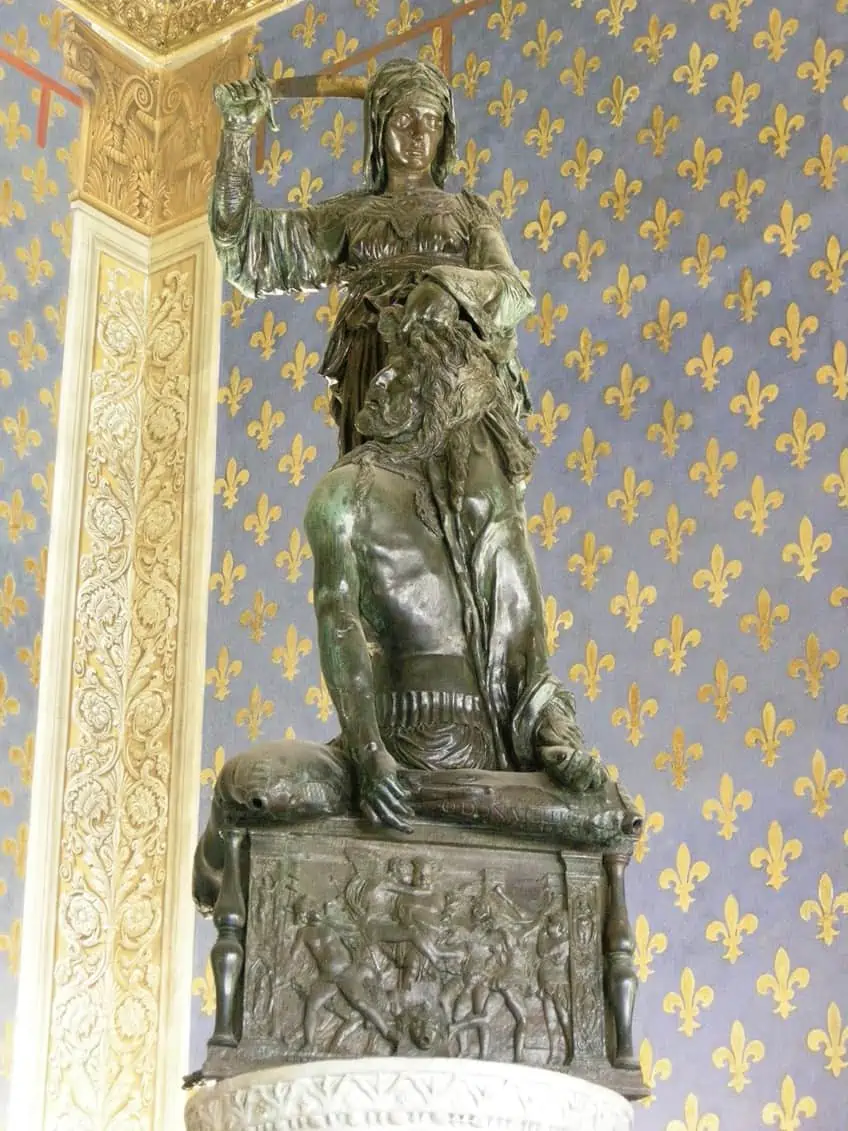
Both famous Renaissance sculptures served as a symbol of the Medici’s power over Florence while existing in their own power. The statue was believed to have been cast in 11 parts to allow for it to be fully gilded. Now, only traces of gilding can be found on the sword, which Judith holds.
Pietà (1498 – 1499) by Michelangelo
| Artist Name | Michelangelo di Lodovico Buonarroti (1475 – 1564) |
| Date | 1498 – 1499 |
| Medium | Marble |
| Dimensions (cm) | 174 x 195 |
| Where It Is Housed | St. Peter’s Basilica, Vatican City |
Pietà (1498 – 1499) is one of the most famous Renaissance sculptures that depicts Mary cradling the body of Jesus after his crucifixion. Housed at the Vatican City, this sculpture combines the ideals of the classical sculpture of the Renaissance with naturalism. Naturalism is often likened to Realism but is more so tied to the idea of the Western representation of objects with minimal distortion.
Here, Michelangelo showcases his mastery over drapery by incorporating the chiaroscuro effect. The chiaroscuro effect is characterized by the use of high, bold contrasts between light and darkness.
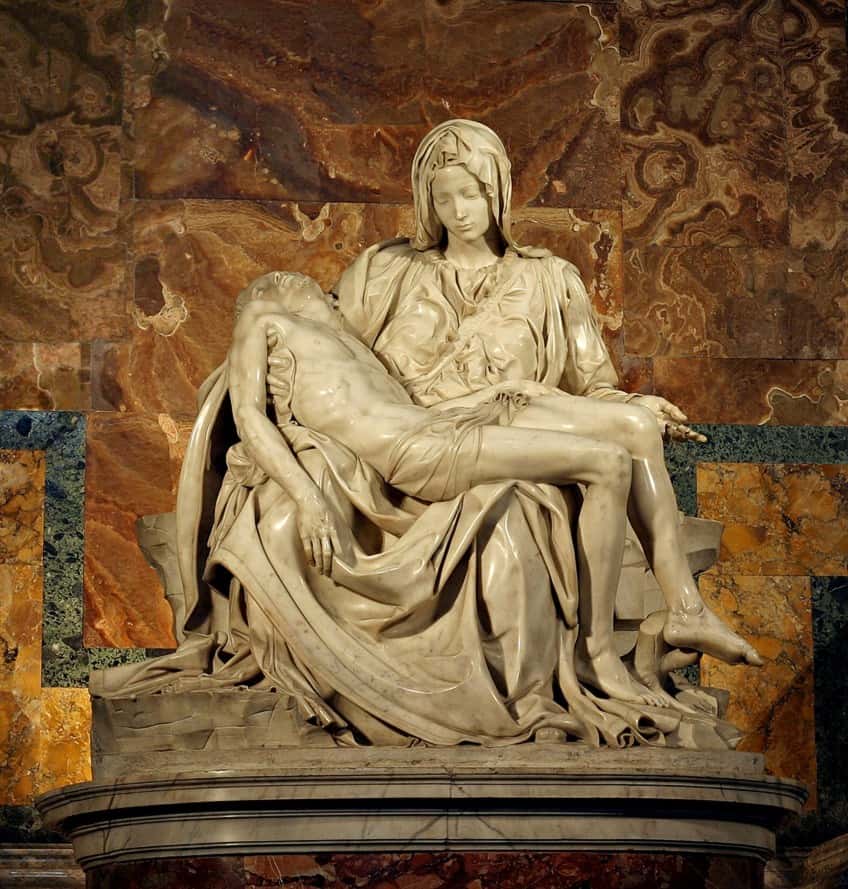
Michelangelo also changed the perspective of Jesus and portrayed him without the traditional expression of the passion on his face. This passion refers to the period in Jesus’ life as he approached his death. He also wished to show, through Pietà, the “heart’s image”. Through sculpture, Michelangelo demonstrates the power of the artist in being able to change the perception of religious figures and associated beliefs.
This also draws attention to the greater impact that the Renaissance had on the enlightenment and cultural development of Europe.
Madonna of Bruges (1501 – 1504) by Michelangelo
| Artist Name | Michelangelo di Lodovico Buonarroti (1475 – 1564) |
| Date | 1501 – 1504 |
| Medium | Marble |
| Dimensions (cm) | 200 |
| Where It Is Housed | Onze Lieve Vrouwekerk, Bruges, Belgium |
This is one of the most famous Renaissance sculptures depicting the Virgin Mary and child, also called Madonna and child. Originally meant for decoration in an altarpiece, this sculpture by Michelangelo differs in its representation of the Madonna and her relationship to the child, Jesus.
The common representation during the time involves Mary being depicted as a pious woman with a gentle smile but here, she is depicted as gazing away from Jesus in a detached manner while Jesus is seen stepping away from her.

The style of this sculpture is also an excellent example of the High Renaissance pyramid style often found in works by Leonardo da Vinci during the late 15th century. Similar to Pietà, Mary is also depicted with an oval-shaped face and drapery demonstrating the chiaroscuro effect. Madonna of Bruges (1501 – 1504) was also Michelangelo’s first sculpture that left Italy during his tenure.
The sculpture was then purchased by two wealthy cloth merchants for approximately 4000 florins.
After this, Madonna of Bruges was moved around Europe twice; the first time in 1794 following the conquering of the Austrian Netherlands during the French Revolution, and the second move was during World War II when German soldiers smuggled it to Germany under many mattresses within a Red Cross truck. The sculpture was then rediscovered in Austria in a salt mine and then returned to Bruges. One can catch a glimpse into the sculpture’s travels in the film, The Monuments Men (2014).
Cristo della Minerva (1514 – 1521) By Michelangelo
| Artist Name | Michelangelo di Lodovico Buonarroti (1475 – 1564) |
| Date | 1514 – 1521 |
| Medium | Marble |
| Dimensions (cm) | 205 |
| Where It Is Housed | Santa Maria sopra Minerva, Rome, Italy |
Christo della Minerva (1514 – 1521) is a famous sculpture of the Italian High Renaissance sculpted by one of the masters of sculpture, Michelangelo. The work was first commissioned in 1514 by Metello Vari, who was a Roman patrician and specified that the nude of Christ should bear the cross in his hands.
Also known as the Risen Christ, the sculpture took off in Michelangelo’s studio but was abandoned in 1515 when Michelangelo found a black vein in the white marble.
Michelangelo quickly sought to build a new version in 1519 to meet his end of the deal on the commission. He began working on the statue in Florence and later entrusted the final touches to his apprentice, Pietro Urbano, who was based in Rome. Unfortunately, Urbano damaged the work so Michelangelo had to find another replacement to finish the sculpture. This time he employed the assistance of Federico Frizzi.

The first version of the sculpture remained with Metello Vari for use in his garden at his palazzo. He treasured it regardless of its rough appearance as if it were gold. Later on, it was found that the statue was put up for sale around 1607 and thereafter disappeared from the records. The first version later reappeared in 2000 after Irene Baldriga recognized the statue at the church of San Vincenzo Martire. The black vein was apparent on Christ’s left cheek and acquired a new title, Giustiniani Christ.
Luckily, the final version of the statue received much adoration from Michelangelo’s contemporaries. It was described as a sculpture “worthy of more than Rome itself” – and this was a comment made strictly in reference to Christ’s knees, made by Sebastiano del Piombo.
The nude Christ stands with his genitals exposed, which references his sexuality and freedom of will over his sexuality. This meant that Christ was not controlled by lust and is symbolic of his victory over sin and death. Later on, in 1546, a bronze loincloth was added to the statue to conceal his genitals.
Abraham and Isaac (1526 – 1532) by Alonso Berruguete
| Artist Name | Alonso González de Berruguete (1490 – 1561) |
| Date | 1526 – 1532 |
| Medium | Polychromed wood |
| Dimensions (cm) | 89 x 46 x 32 |
| Where It Is Housed | Museo Nacional de Escultura, Valladolid, Spain |
Perhaps one of the most famous Spanish painters and sculptors, Alonso Berruguete delivered this famous Renaissance masterpiece between 1526 and 1532. Berruguete made artworks for many wealthy patrons across the Iberian Peninsula. While many depictions of the famous biblical scene have been portrayed with plenty of dramatic flair, Berruguete focuses on the intense emotions expressed by the subjects.
Berruguete skillfully evokes the moment of despair between Abraham and Isaac, prior to their moment of salvation when an angel decides to stop the sacrifice.
Despite being crafted in wood, the statue is painted in exquisite polychrome colors and the technical execution behind the wood is excellent. The drapery around Abraham’s body and Isaac’s torso was made using a technique called estofado. The statue was constructed by Berruguete and his assistants and decorated using a gold leaf covering and polished.
After the gilding, the statue was then coated in a layer of tempera and then scratched away to reveal the gold brilliance underneath, which beautifully highlighted the floral and geometric designs. The technique that Berruguete used to depict the bodies and faces of the figures is known as encarnación. This technique is said to have required a particular skill set and makes this sculpture even more unique.
The faces and bodies of the figures were coated in gesso and then in lead white paint. After this, Berruguete added finer details to the skin tone and hair using pink glazes to add a sense of life.
Perseus with the Head of Medusa (1545) by Benvenuto Cellini
| Artist Name | Benvenuto Cellini (1500 – 1571) |
| Date | 1545 |
| Medium | Bronze |
| Dimensions (cm) | 550 |
| Where It Is Housed | Loggia de Lanzi, Piazza della Signoria, Florence, Italy |
Benvenuto Cellini was an established sculptor and goldsmith of the Italian Renaissance who was also commissioned by Cosimo de’Medici to create this sculpture depicting Perseus with the Head of Medusa. Sculpted in 1545, the sculpture was installed in one of the most central piazzas in Florence, the Loggia, and catches the eye of any passerby.
The statue was created using a single bronze cast, which was uncommon given that many bronze sculptors made their works in separate sections. The base of the statue is also the sculpture itself since Perseus stands over Medusa’s slain body.

Furthermore, Cellini added a personal touch to the statue by including his reflection in the back of Perseus’ helmet and this sparks the interest of the viewer to also critique the role of the artist in sculpture. In one gesture of reflection, Cellini also uses his reflection to remind viewers of the way that Perseus surpassed Medusa’s powers. He evaded her glance by observing her from her reflection on his shield, thus enabling him to defeat and behead her.
The statue of Perseus with the Head of Medusa also served as a reinforcement and reminder of the power that the Medicis had over the people of Italy. Cellini is also best known for his sculpture, Cellini Salt Cellar (1543).
Abduction of a Sabine Woman (1579 – 1583) by Giovanni da Bologna
| Artist Name | Giovanni da Bologna (Giambologna) (1529 – 1608) |
| Date | 1579 – 1583 |
| Medium | Marble |
| Dimensions (cm) | 410 |
| Where It Is Housed | Loggia dei Lanzi, Florence, Italy |
This sculpture is one of the most complex and famous Renaissance sculptures by Giambologna (Giovanni da Bologna), who was a famous Flemish sculptor who received the commission from Cosimo de’ Medici. This work, as with most works commissioned by the Medicis, has become known as a masterpiece due to its outstanding sculptural qualities. The sculpture remained at the Loggia dei Lanzi since 1582 and was created using the figura serpentinata style. This style is employed in sculpture and paintings to add dynamism to the figure.
Abduction of a Sabine Woman (1579 – 1583) portrays three figures in the nude and shows a young man forcefully abducting a young woman from an older man.

The sculpture is based on the large-scale historical incident involving the abduction of many Sabine women by men from Rome during a time when there were few women in the city. The sculpture was also executed according to the Mannerist style, a common trend of High Renaissance sculpture, which is also referred to as the Late Renaissance. The Late Renaissance lasted up until the end of the 16th century when it was replaced by the Baroque style. The figures were all carved from a single block of marble and were not granted a title until their completion.
Giambologna was more focused on demonstrating his sense of virtuosity rather than placing importance on the subject matter.
Apollo and Daphne (1622 – 1625) by Gian Lorenzo Bernini
| Artist Name | Gian Lorenzo Bernini (1598 – 1680) |
| Date | 1622 – 1625 |
| Medium | Marble |
| Dimensions (cm) | 243 |
| Where It Is Housed | Galleria Borghese, Rome, Italy |
Another master of Italian Renaissance sculpture is Gian Lorenzo Bernini who delivered this masterpiece between 1622 and 1625. Apollo and Daphne depicts the mythological figures Apollo, who is the Olympian deity of music, archery, and dance with Daphne, the huntress of Artemis of tremendous beauty.
The sculpture follows the story of Apollo who fell for Daphne’s beauty after being struck by Eros’ arrow. Daphne, who had sworn herself to virginity and singleness, fled from Apollo not knowing who he was, as if prey running from a predator.
Apollo chased Daphne until she begged the stream of her father’s land to rid her of her beauty. Daphne was transformed into a laurel tree but Apollo continued to express his love for her. Bernini’s sculpture of Apollo and Daphne received mixed reviews after his death and in 1839, a spectator commented that the group was “astonishing” for both its “elaborateness and mechanism of art”.
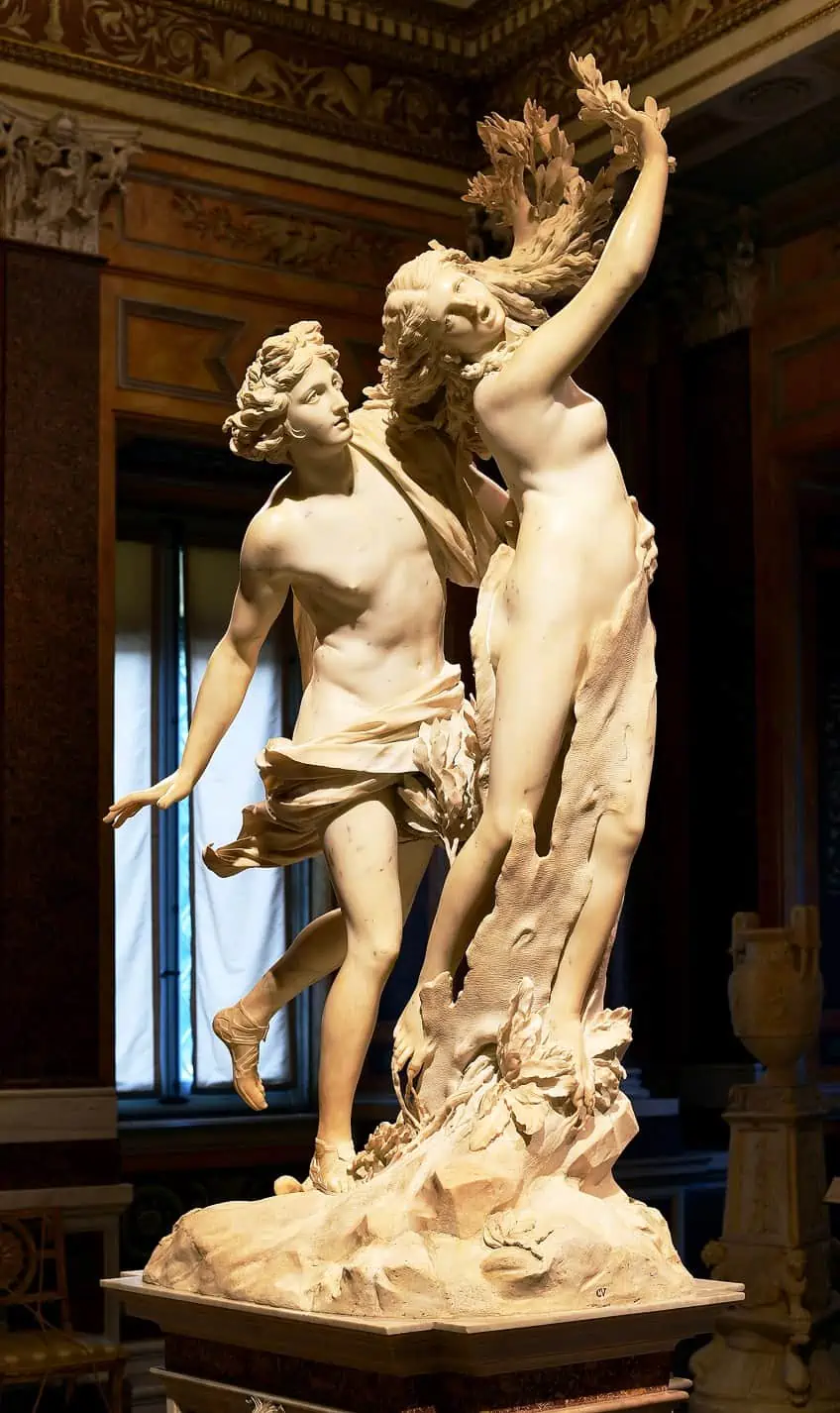
Other reviews include an English writer who admired Bernini’s technical skills but was not as impressed with the fact that his sculpture contains all the “want of judgment, taste, and knowledge” of the Renaissance era. He further criticized the appearance of the statue for being unlike a God and more like a shepherd.
These works of famous Renaissance artists have proven immensely impactful in the way that myths, legends, and religious narratives have been reimagined and understood under the Italian Renaissance and the rest of Europe. These famous Renaissance sculptures have most importantly contributed to the development of sculpture itself and can be used as great touchpoints for study and reinterpretation.
Frequently Asked Questions
What Is the Most Famous Renaissance Sculpture?
The most famous Renaissance sculpture is considered to be a marble statue created by Michelangelo Buonarroti between 1501 and 1504 known as David. The sculpture was inspired by the biblical narrative of David and Goliath and the heroic initiative of David when slaying the giant.
Who Was the Best Renaissance Sculptor?
Michelangelo Buonarotti of the High Renaissance is considered the best sculptor out of all the Renaissance sculptors. Additionally, his work is admired as much as that of Leonardo da Vinci.
Why Is the Renaissance Period Important for Sculpture?
The Renaissance had an important impact on the development of sculpture because it coincided with other developments and world views about politics, science, religion, culture, and social norms, which influenced the way that artists began to interpret and depict different subject matter in sculpture and art in Europe.
Jordan Anthony is a Cape Town-based film photographer, curator, and arts writer. She holds a Bachelor of Art in Fine Arts from the University of the Witwatersrand, Johannesburg, where she explored themes like healing, identity, dreams, and intuitive creation in her Contemporary art practice. Jordan has collaborated with various local art institutions, including the KZNSA Gallery in Durban, the Turbine Art Fair, and the Wits Art Museum. Her photography focuses on abstract color manipulations, portraiture, candid shots, and urban landscapes. She’s intrigued by philosophy, memory, and esotericism, drawing inspiration from Surrealism, Fluxus, and ancient civilizations, as well as childhood influences and found objects. Jordan is working for artfilemagazine since 2022 and writes blog posts about art history and photography.
Learn more about Jordan Anthony and about us.
Cite this Article
Jordan, Anthony, “Famous Renaissance Sculptures – The Top Renaissance Art.” artfilemagazine – Your Online Art Source. October 20, 2022. URL: https://artfilemagazine.com/famous-renaissance-sculptures/
Anthony, J. (2022, 20 October). Famous Renaissance Sculptures – The Top Renaissance Art. artfilemagazine – Your Online Art Source. https://artfilemagazine.com/famous-renaissance-sculptures/
Anthony, Jordan. “Famous Renaissance Sculptures – The Top Renaissance Art.” artfilemagazine – Your Online Art Source, October 20, 2022. https://artfilemagazine.com/famous-renaissance-sculptures/.


